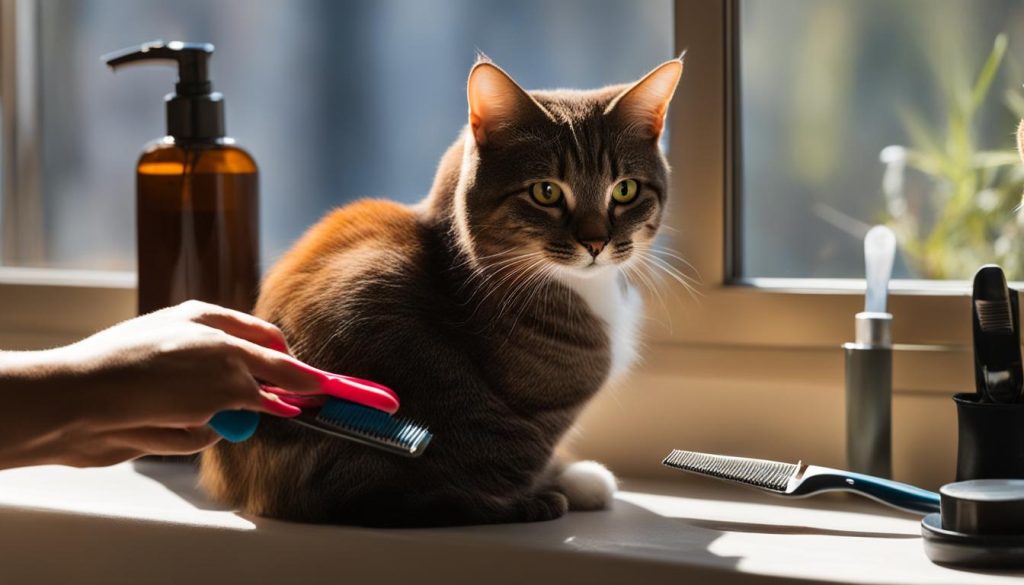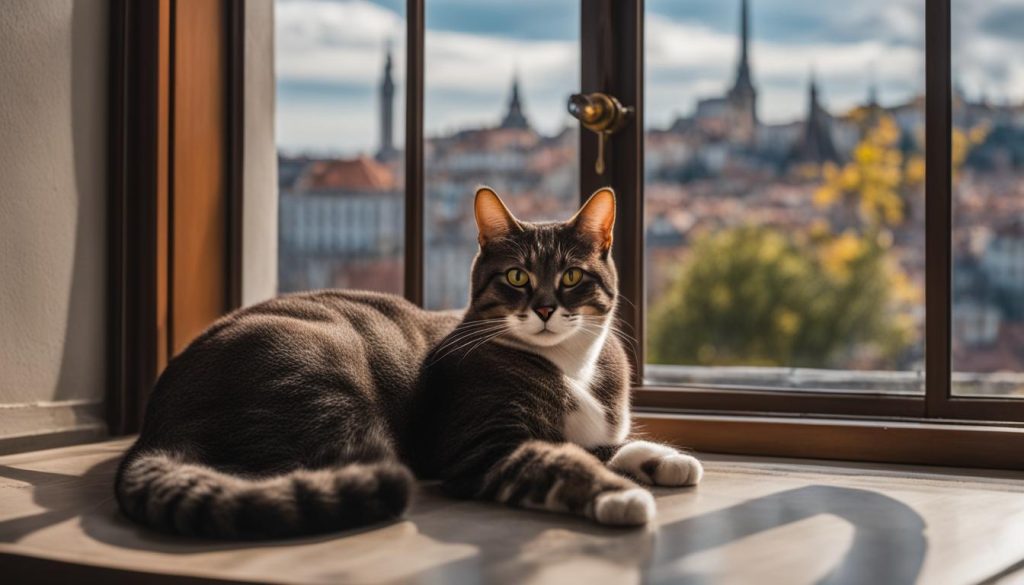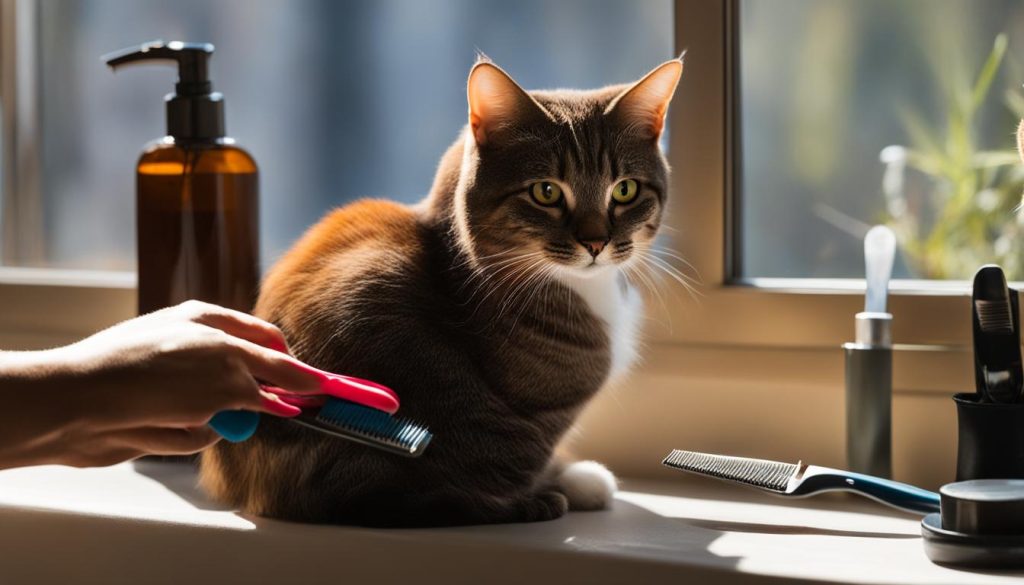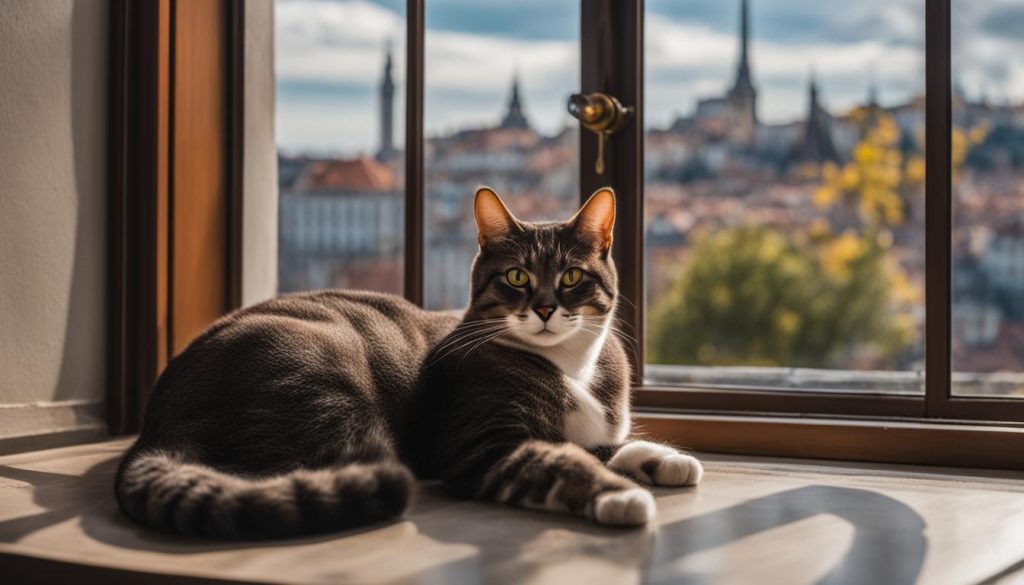Greetings, fellow feline lovers! Today, I want to delve into the fascinating world of the European Shorthair diet and share with you the valuable insights I’ve gained on this important topic. As an avid cat enthusiast and nutrition enthusiast, I’ve always been intrigued by the unique dietary needs of different cat breeds, and the European Shorthair is no exception. So, grab a cup of tea and join me on this educational journey!
Before we dive in, let’s talk a bit about cat nutrition in general. Feeding our furry friends a well-balanced diet is essential for their overall health and well-being. But when it comes to the European Shorthair breed, there are specific dietary considerations that need to be taken into account.
Key Takeaways:
- The European Shorthair breed has unique dietary needs.
- Proper nutrition is crucial for their overall health and well-being.
- A well-balanced diet supports their specific dietary requirements.
- Understanding their dietary needs can help ensure they thrive.
- Consulting with a veterinarian is essential for tailored feeding recommendations.
Now that you have a taste of what’s to come, let’s embark on this exciting journey of exploring the European Shorthair’s diet together!
Understanding the Origins of the European Shorthair Breed
The European Shorthair breed has a fascinating history that dates back to ancient Egypt. These cats were bred as hunting companions in Europe and later gained popularity as household pets. To understand the unique dietary needs of the European Shorthair, it is essential to delve into their origins and ancestry.
European Shorthairs were highly regarded in ancient Egypt for their exceptional hunting skills. They were depicted in ancient artworks and were believed to possess mystical qualities. Over time, these cats made their way to Europe, where they were selectively bred for their desirable traits.
The European Shorthair has a specific set of nutritional requirements that should be met for their overall well-being.
As the breed evolved, European Shorthairs developed a robust physique, known for their muscular build. This breed’s origins as hunters contribute to their need for a diet rich in protein and essential nutrients. Optimal nutrition is key to supporting their physical health and maintaining their natural energy levels.
Origins of the European Shorthair BreedPhysical Traits of the European Shorthair
| Ancient Egypt | Highly regarded as hunting companions |
| Europe | Bred selectively for desirable traits |
| Muscular Build | Requires a diet rich in protein |
Ancient Egyptian Connection
The European Shorthair’s link to ancient Egypt is a fascinating aspect of their heritage. This connection adds to the breed’s allure and highlights their historical significance. By understanding their origins, we can better appreciate the importance of providing a diet that meets their specific nutritional needs.
Stay tuned for the next section, where I will delve into the physical traits and temperament of the European Shorthair breed, shedding light on how their unique characteristics influence their dietary requirements.
Physical Traits and Temperament of the European Shorthair
The European Shorthair is a breed that boasts a distinctive set of physical traits and a charming temperament. With its muscular build, short coat, and dense fur, this cat is not only visually appealing but also well-suited for various environments. Whether living in a small apartment or a spacious house, the European Shorthair adapts effortlessly and brings joy to any home.
One of the notable physical features of the European Shorthair is its short coat, which requires minimal grooming. Regular brushing and combing can help remove loose hair and maintain the health of their fur. Additionally, these cats have a friendly, intelligent, and playful personality, making them beloved companions for individuals and families alike.
When it comes to their diet, the European Shorthair has specific nutritional needs that should be met for their overall well-being. Feeding European Shorthair cats a balanced diet is crucial for their growth, energy levels, and immune system. A diet that includes high-quality proteins, carbohydrates, fats, vitamins, and minerals is essential to support their active lifestyle.
The Importance of a Balanced Diet
Providing a balanced diet for European Shorthair cats ensures that they receive all the necessary nutrients for optimal health. It is recommended to consult with a veterinarian or a professional pet nutritionist to determine the appropriate feeding plan for your feline companion. They can help you understand the specific dietary requirements of the European Shorthair breed and recommend suitable cat food options.
In conclusion, the European Shorthair is a remarkable breed with both unique physical traits and a delightful temperament. By ensuring they receive a well-balanced diet that meets their nutritional needs, we can help these cats thrive and lead a healthy and happy life.
Health and Care Tips for European Shorthairs
Ensuring the health and well-being of your European Shorthair involves understanding their specific dietary needs and providing them with the right cat food. These cats are generally healthy and have a lifespan of 12-15 years, but regular veterinary check-ups and proper nutrition are essential for maintaining their optimal health.
The dietary needs of European Shorthairs can vary depending on their age, weight, and activity level. It is important to feed them a balanced and nutritious diet that includes high-quality protein, essential fatty acids, and a good balance of vitamins and minerals. Look for cat foods specifically formulated for European Shorthairs or consult with your veterinarian to determine the best food options for your furry friend.
In addition to feeding them the right cat food, it is important to provide your European Shorthair with clean water at all times. Hydration is crucial for their overall health and helps prevent urinary tract issues. You should also monitor their weight and adjust their food portions accordingly to prevent obesity.
Grooming and Dental Care
European Shorthairs have short coats that require minimal grooming. However, regular brushing helps to remove loose hair and minimize shedding. It is also important to clean their ears and trim their nails regularly to maintain their hygiene.
Dental care is another crucial aspect of their overall health. Dental issues can lead to discomfort and a decreased appetite. To prevent dental problems, consider providing your European Shorthair with dental treats or using specially designed toothbrushes and toothpaste for cats. Regular dental check-ups with your veterinarian are also recommended.
| Health and Care Tips for European Shorthairs |
|---|
| Feed a balanced and nutritious diet |
| Provide clean water at all times |
| Monitor weight and adjust food portions accordingly |
| Regular grooming to remove loose hair |
| Clean ears and trim nails regularly |
| Provide dental care and regular dental check-ups |
“Proper nutrition and regular veterinary care are key to ensuring the health and well-being of your European Shorthair. By providing them with a balanced diet, clean water, and regular grooming, you can help them lead a happy and healthy life.”
By paying attention to their dietary needs, grooming, and dental care, you can ensure that your European Shorthair remains in optimal health and enjoys a long and fulfilling life as your beloved companion.
Training and Socializing European Shorthairs
When it comes to training and socializing European Shorthairs, a recommended diet and nutrition tips play an essential role in their overall development. These intelligent and active cats require mental and physical stimulation to thrive. By providing them with a well-balanced diet, you can ensure they have the energy and nutrients needed for training and social interactions.
“Proper nutrition is key for European Shorthairs to reach their full potential in training and socializing,” says Dr. Sarah Johnson, a feline nutrition expert.
“A diet rich in high-quality protein, such as chicken, turkey, or fish, can support their active lifestyle and promote muscle development. Additionally, ensuring they receive the right vitamins and minerals, such as taurine and omega-3 fatty acids, can contribute to their cognitive function and overall well-being.”
As you embark on the journey of training your European Shorthair, incorporating nutrition-focused activities can be beneficial. For example, using puzzle feeders or food-dispensing toys can engage their natural hunting instincts while providing mental stimulation. This can help prevent boredom and encourage them to participate actively in the training process.
| Training and Socializing Tips for European Shorthairs | Recommended Diet and Nutrition Tips |
|---|---|
| Start socializing at a young age to familiarize them with different environments and people. | Provide a balanced diet with high-quality protein, vitamins, and minerals. |
| Use positive reinforcement techniques, such as treats and praise, to encourage desired behaviors. | Incorporate interactive feeding methods, like puzzle feeders and food-dispensing toys, for mental stimulation. |
| Introduce them to new experiences gradually and in a controlled manner. | Ensure they have access to fresh water at all times to stay hydrated. |
| Establish a consistent training routine to reinforce discipline and obedience. | Consult with a veterinarian or feline nutrition expert to determine the right diet for your European Shorthair. |
Training and socializing European Shorthairs can be a rewarding experience for both you and your feline companion. By providing them with a recommended diet and incorporating nutrition tips into their training regime, you can help them develop into well-rounded and sociable cats.
Table: Recommended Grooming Routine for European Shorthairs
| Grooming Aspect | Frequency |
|---|---|
| Brushing and combing | Once a week |
| Ear cleaning | Every 2-3 weeks |
| Claw trimming | Every 2-4 weeks |
European Shorthairs in the Home: Ideal Settings and Interactions
As a cat lover and owner, I’ve discovered that European Shorthairs are versatile and adaptable cats that can thrive in various home environments. Whether you live in a small apartment or a spacious house, these feline companions will adjust and make themselves at home. However, there are a few key considerations to keep in mind to ensure their happiness and well-being.
Creating an Enriching Environment
European Shorthairs are active and curious by nature, so providing them with plenty of space to explore and play is essential. Set up a dedicated area for them that includes scratching posts, toys, and cozy bedding where they can retreat and relax. By offering different levels, such as shelves or cat trees, you’ll encourage their natural climbing and exploring behaviors.
In addition to physical stimulation, mental stimulation is equally important for these intelligent cats. Interactive puzzles, treat-dispensing toys, and regular play sessions will keep their minds sharp and prevent boredom. Consider rotating their toys to keep them engaged and provide a varied play experience.
Introducing European Shorthairs to Family and Pets
When bringing a European Shorthair into your home, it’s crucial to introduce them properly to new family members and other pets. Take it slow and allow them time to adjust to their new surroundings. Create a separate space initially where they can feel safe and gradually introduce them to different areas of the house.
If you have other pets, introduce them gradually and under controlled circumstances. Use scent swapping techniques to familiarize them with each other’s scents before allowing direct interaction. Supervise their initial interactions and provide positive reinforcement for calm and friendly behavior.
Respecting Their Territory
European Shorthairs have a strong sense of territory, so it’s important to be mindful of this when introducing them to new environments or introducing new objects into their existing territory. Allow them to explore at their own pace and provide hiding spots where they can retreat if they feel overwhelmed. By respecting their need for personal space and territory, you’ll foster a sense of security and trust.
Remember, each cat is unique, and their preferences may vary. Pay attention to their body language and respond accordingly. By providing a stimulating environment, introducing them to new family members and pets gradually, and respecting their territory, you’ll create an ideal setting for your European Shorthair to thrive.
| Tip | Description |
|---|---|
| Provide vertical space | European Shorthairs love to climb and explore. Install shelves or cat trees to satisfy their natural instincts. |
| Rotate toys | Keep their playtime exciting by periodically introducing new toys and rotating them. |
| Use scent swapping techniques | When introducing them to other pets, allow them to familiarize themselves with each other’s scents before direct interaction. |
| Provide hiding spots | Offer hiding spots where your European Shorthair can retreat and feel secure. |
How to Introduce a European Shorthair to a New Home
Bringing a European Shorthair into a new home can be an exciting experience, but it is important to ensure a smooth transition for your new feline friend. Here are some tips on how to introduce a European Shorthair to their new environment:
Create a Safe and Calm Space
When you first bring your European Shorthair home, it is essential to provide them with a separate space where they can feel safe and calm. Set up a quiet room with all their essentials, such as food, water, litter box, and a comfortable bed. This space will give them time to adjust to the new surroundings without feeling overwhelmed.
Gradual Introductions
Once your European Shorthair has settled into their safe space, you can start introducing them to other areas of the home and other family members. It’s crucial to take it slow and gradually increase their exposure to different rooms and people. This approach helps reduce stress and anxiety, allowing them to acclimate at their own pace.
Introducing to Other Pets
If you have other pets, it’s important to introduce them to your European Shorthair gradually. Begin by allowing them to sniff each other through a closed door or baby gate. Gradually increase their interaction time, supervised, until they become comfortable with each other’s presence. Patience and positive reinforcement are key during this process.
By following these steps, you can help your European Shorthair feel comfortable and secure in their new home, ensuring a smooth transition for both you and your feline companion.
Overcoming Breed-Related Challenges of European Shorthairs
European Shorthair cats, like any breed, may present specific challenges that owners need to address. Understanding these challenges and implementing appropriate strategies can help ensure a harmonious and fulfilling relationship with your European Shorthair companion.
Common Behavioral Challenges
One challenge that European Shorthairs may exhibit is climbing on countertops or other high surfaces. This behavior can be both frustrating and potentially dangerous. To discourage this behavior, provide alternative vertical spaces and interactive toys to redirect their climbing instincts. Additionally, using deterrents such as double-sided tape or aluminum foil on countertops can help discourage the behavior.
Another common challenge is furniture scratching. European Shorthairs have a natural instinct to scratch, which helps them maintain healthy claws and mark their territory. To prevent damage to furniture, it’s important to provide them with appropriate scratching posts or boards. Place these in areas where they are likely to scratch, such as near their favorite resting spots or near furniture they often target.
Dietary Challenges
European Shorthairs can be prone to weight gain if not provided with a balanced diet and proper portion control. Obesity can lead to various health issues, including diabetes and joint problems. To maintain a healthy weight, ensure you are feeding your European Shorthair a high-quality cat food that is specifically formulated for their nutritional needs. Consult with your veterinarian for recommendations on portion sizes and feeding frequency.
Environmental Enrichment
European Shorthairs thrive in environments that provide mental and physical stimulation. Lack of stimulation can lead to boredom and undesirable behaviors such as excessive vocalization or destructive tendencies. To prevent these challenges, engage your European Shorthair with interactive toys, playtime, and puzzle feeders that encourage mental stimulation. Additionally, creating vertical spaces and hiding spots can satisfy their natural climbing and seeking instincts.
| Common Challenges | Preventive Measures |
|---|---|
| Climbing on countertops | – Provide alternative vertical spaces – Use deterrents such as double-sided tape or aluminum foil on countertops |
| Furniture scratching | – Provide appropriate scratching posts or boards – Place near favorite resting spots or targeted furniture |
| Weight gain | – Feed a balanced diet for nutritional needs – Control portion sizes and frequency |
| Lack of mental stimulation | – Engage with interactive toys and playtime – Provide vertical spaces and hiding spots |
By understanding and addressing these breed-related challenges, you can create a nurturing and fulfilling environment for your European Shorthair cat. Providing them with a balanced diet, environmental enrichment, and plenty of love and attention will help ensure their overall well-being and a harmonious relationship.
Common Questions About European Shorthairs
As a prospective owner of a European Shorthair, you may have some questions about this unique breed. Here are answers to some common inquiries:
Are European Shorthairs suitable for families with children?
The European Shorthair is known for its friendly nature and can make a great companion for families with children. They are playful and patient, making them well-suited for households with kids. However, it is important to teach children how to handle cats gently and respect their boundaries to ensure a harmonious relationship.
Can European Shorthairs live with other pets?
European Shorthairs can typically get along well with other pets, including dogs and other cats. However, proper introductions should be done gradually and supervised to ensure a smooth transition. Providing separate spaces and resources for each pet initially can help prevent conflicts and promote a peaceful coexistence.
What is the ideal diet for a European Shorthair?
A balanced diet is essential for the overall health and well-being of your European Shorthair. High-quality commercial cat food that is specifically formulated for their nutritional needs is recommended. It is important to provide a mix of wet and dry food to ensure they are getting the right balance of nutrients. Consult with your veterinarian for specific dietary recommendations based on your cat’s age, weight, and any specific health concerns.
Remember, each European Shorthair is unique, and their needs may vary. It’s always a good idea to consult with a veterinarian for personalized advice based on your cat’s individual requirements.
| Question | Answer |
|---|---|
| Are European Shorthairs suitable for families with children? | Yes, European Shorthairs are friendly and can make great companions for families with children. |
| Can European Shorthairs live with other pets? | Yes, European Shorthairs can typically get along well with other pets, including dogs and cats. |
| What is the ideal diet for a European Shorthair? | A balanced diet of high-quality commercial cat food is recommended, with a mix of wet and dry food. |
Conclusion
After delving into the world of European Shorthairs, I have discovered that this breed requires a specialized diet to ensure their optimal health. With their unique temperament and history dating back to ancient Egypt, it is important to understand their specific nutritional needs.
Providing a balanced and nutritious diet is key to maintaining the overall well-being of European Shorthairs. Their muscular build and friendly personality make them wonderful companions, but it is essential to meet their dietary requirements for them to thrive.
By offering a well-rounded meal plan and considering their specific dietary needs, European Shorthairs can enjoy a healthy and fulfilling life. From regular vet visits to providing them with the right cat food, taking care of their nutritional needs is crucial.
With the proper diet, training, grooming, and socialization, European Shorthairs can bring immense joy and become cherished members of any family. Understanding their history, physical traits, and health concerns will guide you in providing them with the care they deserve.
FAQ
What is the history of the European Shorthair breed?
The breed originated in Europe and was used for hunting before becoming popular as pets.
What are the physical traits and temperament of European Shorthairs?
European Shorthairs have a muscular appearance and friendly personality.
What type of diet should I feed my European Shorthair?
It is important to provide them with a balanced and nutritious meal that meets their specific dietary requirements.
How long do European Shorthairs typically live?
They have a lifespan of 12-15 years with regular vet visits and a healthy diet.
Are European Shorthairs trainable?
Yes, they are intelligent and can be trained to perform tasks and tricks.
Do European Shorthairs require a lot of grooming?
They have short coats that require minimal grooming, but regular brushing and ear cleaning are recommended.
How should I introduce a European Shorthair to my home?
Give them time to acclimate and introduce them gradually to new people and pets.
What are some common challenges with European Shorthairs?
They may exhibit behaviors like scratching furniture, which can be addressed with a balanced diet and stimulation.
Are European Shorthairs suitable for families with children and other pets?
Yes, they are versatile and adaptable and can thrive in various home environments when properly introduced.
What are some common questions about European Shorthairs?
People often ask about their suitability as pets, grooming requirements, and health concerns.













